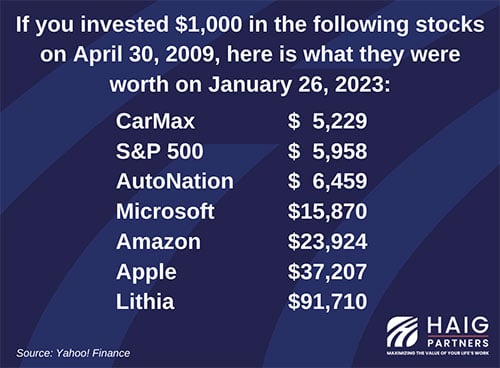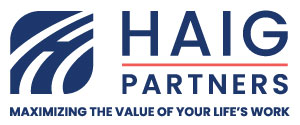Q: The 2023 NADA Show is now solidly in the rearview mirror. What were some of your takeaways?
Alan Haig: At the NADA Show in Dallas, I had the pleasure of speaking with Bryan DeBoer, Chief Executive Officer, President and Director of Lithia Motors, for an hour onstage in Dallas during a conference Haig Partners helps organize.
I started by putting up a slide that showed that a $1,000 investment in Lithia on April 30, 2009, was worth $91,170 on January 26, the day of our discussion. This appreciation in value was far more than other auto retailers’ stocks and superior to the best-known tech stocks during that same period. The main reason? Lithia grew faster.
In 2008, Lithia generated $2.1 billion in revenue from 96 dealerships. By 2022 its revenue had jumped to more than $30 billion from 282 dealerships. Some of this revenue growth came from increases in same-store sales, due to improved operations. However, the large majority of it came from acquisitions that fit Lithia’s strategy to build out a nationwide network of larger-than-average dealerships located within 100 miles of almost every person in the United States. After it builds out its physical network of stores, Lithia wants to use its Driveway website to sell and deliver vehicles to people who reside outside its markets, giving it the capability to sell vehicles profitably to almost everyone in the U.S. As such, Lithia is on track to be the first truly national U.S. auto retailer.

Q: What does the growth strategy for the public retailers mean for smaller dealers looking to grow?
Haig: Despite this growth by Lithia and several other well-known consolidators, auto retail remains highly fragmented. There are around 8,500 dealers in the U.S., with a typical dealer owning two stores and working hard to achieve his or her American dream. Thanks to franchise laws in each state, small dealers have been able to compete effectively with the largest auto retailers. Due to changes in consumer behavior and new technologies, however, we believe larger dealer groups will gradually gain a growing advantage over smaller dealers. Since our team is keenly focused on helping dealers maximize the value of their lives’ work, we are encouraging smaller dealers to take steps today to grow their organizations so that they are less at risk from larger competitors. In the words of the late Sam Swope, the co-founder of the Swope Family of Dealerships, “When you’re green, you’re growing; and when you’re ripe, you’re rotting.”
Fortunately, retailers don’t have to grow nearly as big as Lithia to create value and ensure their long-term success. Some friends have estimated that if retailers can grow to 10 or more stores in a market, they will be strong enough to thrive over the long term. And 20 stores are better than 10. Growing retailers can better protect the current value of their companies and have the opportunity to significantly expand their net worth within a relatively short period of time.
Q: Walk us through the specifics of how adding stores drives value.
Haig: Here are some key benefits that growth brings for private retailers:
- High return on investment. Most dealership buyers expect that acquisitions will deliver a long-term pre-tax return on investment of more than 20 percent on the amount of equity they invest.
- Larger selection for consumers. Having a higher number of stores gives dealers a greater ability to attract and retain customers by offering more brands in the local area and a larger inventory.
- Diversification. Larger groups enjoy lower costs for accounting, advertising, IT, supplies, etc.
- Economies of scale. This lowers costs for accounting, advertising, IT, supplies, etc.
- Larger talent pool. Acquisitions can bring more talent into an organization, and more opportunities for advancement can help retain the best employees.
The net result of the benefits I just mentioned is that growing retailers should gradually begin to outperform smaller retailers who do not reinvest and grow. The growing retailer evolves into an investor, choosing where to allocate his financial and human capital to achieve the best possible long-term return on investment. The retailer who chooses not to grow could end up on the defensive, trying to hold onto his customers and his teammates, who may all naturally gravitate toward growing dealership groups.
Q: Growing from two stores to ten stores seems difficult. Can retailers finance this growth on their own or will they need an outside investor?
Haig: We have conducted an analysis that shows it is possible for the typical dealer with two stores today to grow to 10 stores within a decade. No outside investment is required, although some retailers might like to attract outside capital to help them grow even faster. For discussion purposes, let’s call this company Our Town Auto Group. We have used assumptions that we believe to be realistic, but of course, the future is hard to predict. For the purpose of this demonstration, Our Town Auto Group has two dealerships that are making $4 million in pre-tax profit per location. These dealerships are worth $50 million today, inclusive of $10 million of investible capital plus blue sky, plus assets, minus debt.
The chart below shows our estimates for the value Our Town Auto Group could create if it reinvested all of its capital in dealership acquisitions. According to our investment model and key assumptions below the chart, it could grow from two stores to 10 stores in a decade and increase its equity value from just shy of $50 million to over $150 million. And the same math works for larger groups. A group of 10 stores that pursued the same strategy could grow to 50 stores and increase its value from $220 million to more than $740 million.
Of course, there are risks associated with keeping all your capital in a single industry. Many analysts have pointed out threats to the auto retail business model posed by electric vehicles, changes to franchise laws, new entrants like Tesla and Rivian, the agency model, autonomous vehicles, etc. But we also know that franchised dealerships have existed for well over 100 years and they have steadily grown in value, thanks to population growth and dealers’ entrepreneurial spirit. The American dream is alive in auto retail, one of the last bastions where family-owned businesses can compete and hold their own against multibillion-dollar enterprises. For those dealers who have the capital, talent and energy for growth, a bright future is beckoning – if they can evolve from being caretakers to empire builders.
For those dealers who are uncomfortable with keeping their capital in dealerships, there is a ready market of buyers eagerly seeking to purchase them. More than 500 dealerships traded hands last year, and at all-time high values. Our firm is proud to have advised on the sale of 41 dealerships last year and helped 15 families exit the industry and move on to other activities. Contact us if you would like to have a confidential conversation about the value of your business.
KEY ASSUMPTIONS:
1. Our Town Auto Group begins with 2 stores that are making $4 million per location. It owns its dealership facilities and each one is worth $10 million and has no mortgage outstanding. Net assets per location are worth $500,000 and Our Town Auto Group has $10 million in cash available to invest.
2. Earnings decline 15% annually until reaching 110% of 2019 earnings in year 7; 2% growth thereafter. More optimistic projections will allow higher growth and higher returns.
3. 100% of after-tax cash flow is invested at the beginning of each year.
4. The blue sky multiples climb from 3.0x trailing 12 months pre-tax profit in the early years to 5.0x, as earnings decline, due to lower margins and higher expenses. Peak blue sky is in year 1.
5. Real estate values increase 1.8% per year net of depreciation.
6. Typical tax, amortization and depreciation rates along with industry borrowing rates assume 50% advance of blue sky and 80% advance of real estate.
7. Our Town meets its sales effectiveness requirements and customer satisfaction in all its dealerships, in all years, for the OEMs to approve its applications to acquire dealerships.
8. Facilities are image-compliant. Model created by Nate Klebacha, Managing Director, Haig Partners
Model created by Nate Klebacha, Managing Director, Haig Partners
ABOUT HAIG PARTNERS
Haig Partners LLC helps dealers maximize the value of their businesses when they are ready to sell. The team at Haig Partners has unmatched experience, with executives from leading retail dealer groups and financial institutions. The team has advised on the purchase or sale of more than 590 dealerships worth more than $9.3 billion and has represented 25 groups that qualify for the annual Automotive News list of Top 150 Dealership Groups, more than any other firm. Haig Partners leverages its expertise and relationships to lead clients through a confidential and customizable sales process that also maximizes the value of their businesses. It publishes the Haig Report, the industry-leading quarterly report that tracks trends in auto retail and their impact on dealership values, and is the co-author of the National Automobile Dealers Association’s guide, Buying and Selling a Dealership. For more information, visit www.haigpartners.com or contact Alan Haig at [email protected] or (954) 646-8921.
